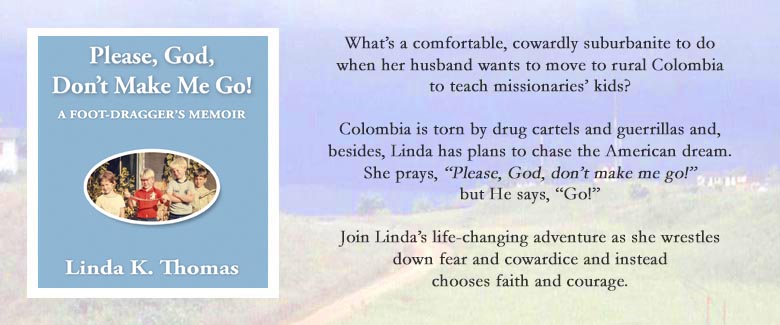If I’d known Lomalinda had such lush flowers, perhaps I wouldn’t
have dreaded moving there quite so much.
Our lives are so much richer for flowers, don’t you think? “Where
flowers bloom,” said Lady Bird Johnson, “so does hope.” What a lovely thought.
As a native of the Pacific Northwest, I knew nothing about tropical
flowers except for what I’d run across in a florist shop or greenhouse. Was I
in for a surprise!
Here’s an excerpt from Chapter 11 of Please, God, Don’t Make Me Go: AFoot-Dragger’s Memoir:
Tropical vegetation surrounded us, hurrying to grow taller and thicker. Hibiscus plants sprouted everywhere, covered with new crimson blossoms each morning. Cup of Gold, with its large yellow flowers, grew around our center; white and golden Frangipani (Plumeria) gave off a heady, tropical fragrance; and Bird of Paradise grew wild in low swampy areas.
Begonias in red and pink thrived in shade; Veinte de Julio, or July 20, named for Colombia’s independence day, showed off large frilly blossoms of orange and yellow; Mimosa lined pathways, decorated with tiny lavender-colored poofs; Lantana bloomed in red, orange, and gold, and Lomalinda was home to many more flowers and vines I couldn’t name.
Some people collected orchids, gathering them from low jungle areas. Glenny Gardner’s brother, Tommy, had an orchid shed with purple cattleyas, small yellow ones, white ones, and strings of tiny pinks–a dazzling display.
And gardenias grew along the entire length of our house. Gardenias! A hedge of gardenias! During my teen years, a young man might give a gardenia corsage to his prom date, but in Lomalinda gardenias by the hundreds, gardenias by the thousands, bloomed outside our windows, their inebriating perfume filling the air.
And how could I have left bougainvillea off that list? Their hot pink
blossoms, or red, or orange, simply glowed under brilliant sunshine.
Living among such flowers was a new experience for me.
And it was not just the flowers—it was the trees, too.
Palm trees were new to me. I’d seen photos, of course, but to live
among them—that was utterly exotic.
Here’s another excerpt from Chapter 11:
A variety of trees edged our yard: lemon, papaya, avocado, mango, a bamboo grove, a tree with round pink blossoms resembling a burst of fireworks, and a tree people called Jungle Ice Cream. Kids pried open its pods—a couple of feet long—and ate cotton-candy-like fluff surrounding the seeds.
I still have to pinch myself: Lemon trees grew in my yard! And papayas,
avocados, and mangos. Unreal!
I was in for pleasant new experiences with Lomalinda’s vegetation, but beforehand,
while I was still in the States, I couldn’t have guessed that. I was begging, “Please,
God, don’t make me go to Lomalinda!”
When I got there, my life fell apart and I plotted to run away.
I wish I’d known then about award-winning author Barbara Johnson’s wise words:
Yes, I’d have to go through a lot of “dirt”—doubts, difficult transitions,
tears, homesickness, despair—before I could bloom where I was planted.
Barbara continues: “The Almighty Father will use life’s reverses to
move you forward.”
I can attest to that. What seemed like reverses turned out to be tools
God used to move me forward and upward.
When recalling those early experiences in Lomalinda, it hurts a bit. But
I share them with you in case you’re going through troubling times—your own “dirt.”
Perhaps God is moving you toward something beautiful, something precious.
Watch for it—watch for the days when you’ll be blooming where you are planted.






